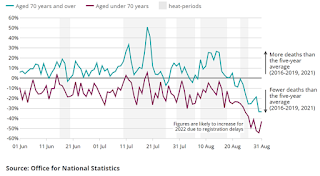
#17,049
As horrific as the impacts of Hurricane Ian on South Florida have been, when it comes to weather-related deaths, hurricanes, tornadoes, blizzards, and floods all pale when compared to heat waves.
Over the years we've looked at their impacts, including the aftermath of a summer 2012 Derecho that left millions without power in 4 states (Maryland, Ohio, Virginia, and West Virginia).
This report describes 32 heat-related deaths in Maryland, Ohio, Virginia, and West Virginia that occurred during the 2 weeks following the storms and power outages. Median age of the decedents was 65 years, and most of the excessive heat exposures occurred within homes. During 1999–2009, an annual average of 658 heat-related deaths occurred in the United States (2).
Eight years later, a heat wave across the central and eastern part of the nation killed as many as 7,500 people (cite). More recently, in 1999, a prolonged heat wave along the Eastern seaboard is believed to have killed 500 (cite).
While rarely mentioned, modern building architecture and home design often contribute to heat related deaths. Many windows no longer open, ceilings are lower, overhangs shorter, and temperature control is nearly completely dependent upon high tech equipment and a steady supply of electricity.Between climate change, growing urban populations, and increasingly fragile infrastructure - particularly involving the power grid - the public health threat from prolonged heat waves is only expected to rise.
Over the summer the UK experienced a series of heatwaves, for which the country is unaccustomed to dealing with. Today, the UKHSA and ONS (Office for National Statistics) released a preliminary report, reporting thousands of excess deaths over the summer.
UKHSA and ONS release estimates of excess deaths during summer of 2022
A joint report by UKHSA and the Office for National Statistics (ONS) shows the effect of this summer’s record temperatures on excess mortality.
From:UK Health Security Agency Published 7 October 2022
Initial analysis by the UK Health Security Agency (UKHSA) shows that across the 5-heat periods in the summer of 2022, the estimated total excess mortality (excluding coronavirus (COVID-19)) in England was 2,803 for those aged 65 and over. This is the highest excess mortality figure during heat-periods observed since the introduction of the Heatwave plan for England in 2004.
In July, some places in England recorded temperatures of over 40 degrees Celsius for the first time in recorded history and UKHSA issued its first ever Level 4 Heat Health Alert. From 17 to 20 July, when temperatures were at their highest, there were an estimated 1,012 excess deaths in those aged over 65.
The heat-period in the summer of 2022 with the highest excess mortality overall was from 8 to 17 August, which saw an estimated 1,458 excess deaths (excluding COVID-19) in those over the age of 65.
These figures demonstrate the possible impact that hot weather can have on the elderly and how quickly such temperatures can lead to adverse health effects in at-risk groups.
Similarly, ONS analysis from the same timeframe – June to August 2022 – for all age groups and for England and Wales, shows a recorded 3,271 deaths above the 5-year average. This represents a 6.2% increase. This is slightly higher than the UKHSA figure as it does not exclude deaths from COVID-19, those under the age of 65 and does include data for Wales.
Isabel Oliver, Chief Scientific Officer at UKHSA, said:
- These estimates show clearly that high temperatures can lead to premature death for those who are vulnerable. Higher excess deaths occurred during the hottest days this year and a warming climate means we must adapt to living safely with hotter summers in the future.
- Prolonged periods of hot weather are a particular risk for elderly people, those with heart and lung conditions or people who are unable to keep themselves cool such as people with learning disabilities and Alzheimer’s disease.
Sarah Caul, Head of Mortality Analysis at the ONS, said:
- During the UK summer of record-breaking temperatures, there was an increase in deaths. However, these spikes around the hottest days were followed by periods of below average mortality. This is likely to be a result of short-term mortality displacement, especially among older age groups, where people died a few days or weeks earlier than expected. This trend is consistent with what we have seen in previous summers with heatwave periods.
- It is also the case that despite peaks in mortality during heatwaves, the majority of days in the winter period (December to March) show a higher number of deaths than we see during summer.
UK Health Security Agency press office
Prime among them are a couple of USB powered fans (see below), along several USB battery packs, and a way to recharge them (solar) should the power stay out for several days.
And lastly, some advice from the CDC's EXTREME HEAT website. Follow the link to learn to learn how to prepare for, and respond to, extreme heat events.


